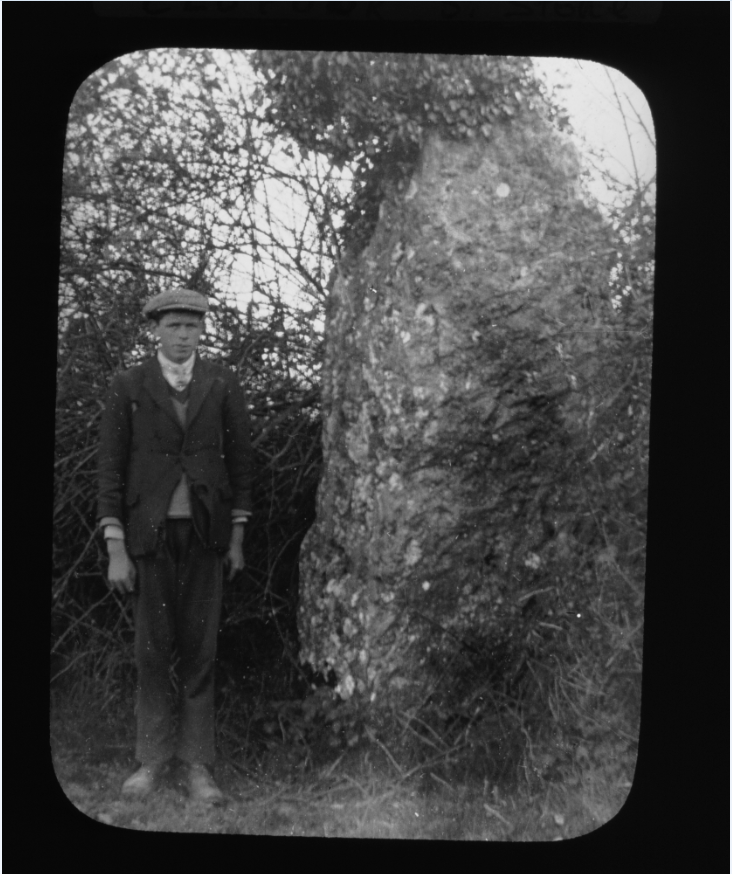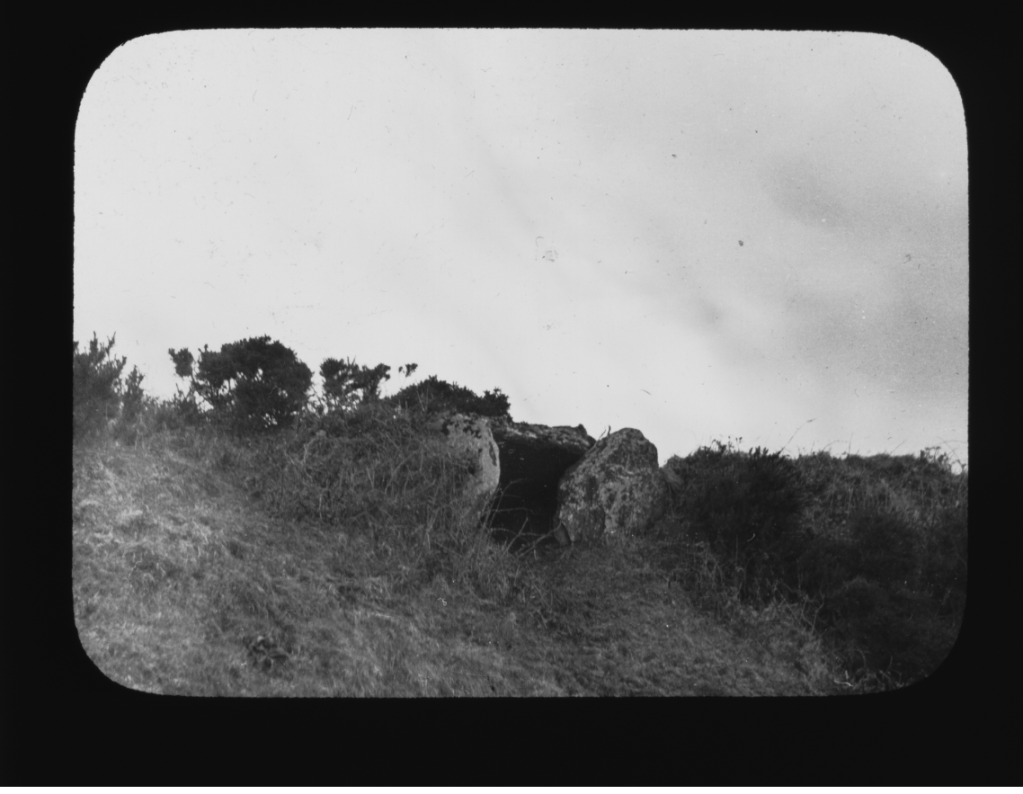Tales, Customs and Beliefs from Laoighis
The Giants and the Standing Stone

Edit: It has come to our attention that the man titled as 'Unknown male' in Helen Roe's Lantern Slides, is Thomas Byrne, originally of Aughrim, Co. Wicklow, the son of Daniel Byrne of Fallowbeg and nephew of Laurence Byrne of Tullamoy, the landowner of where the standing stone was situated. Thomas was due to inherit the farm lands from Laurence, but caught pneumonia and passed away at the young age of 21yrs. His remains lie in Clopook graveyard. Thank you to Gemma Lynch, Thomas' grand-niece for the information.
There is a large Standing Stone at a little distance from the Dun-of-Clopook, and the following story is told locally:
Long ago, there were giants in the land, and the giant who lived at Dunamase was visiting the giant who lived at Clopook.
They began to boast one with the other as to who could fling a stone the farthest. The giant from Dunamase picked up a great rock and pegged it with all his might. It fell at Castledermot, near Athy. When the giant of Clopook saw such a feeble throw he burst out laughing, and the big stone fell out of his hand into the ground, where it stands beside the Dun-of Clopook to-day.
The Ass’ Manger
 The Ass' Manger Lugacurren. Image courtesy of the Helen Roe Lantern Slide Collection held in Laois Local Studies Library.
The Ass' Manger Lugacurren. Image courtesy of the Helen Roe Lantern Slide Collection held in Laois Local Studies Library.
There is a dolmen standing on Coolrus Hill, above Luggacurren. O’Byrne says that funerals have been seen in the afternoon passing down from this dolmen to a field below, where, he says, cists have been found. The funerals disappear from sight when they reach this field.
There is a cave under Dún-of-Clopook. O’Byrne says there is a spirit or phooka in this cave, which frequently presented itself in the form of a fleece of wool, which issued from the cave, roamed over the fields with astonishing celerity. Its motions were accompanied by a buzzing sound.
In the neighbourhood, he says, a battle was fought between two hosts of the Sidhe (the ancient race of people who lived in Tír na nÓg), and the bushes and hawthorn trees were smashed and trampled and specked with blood.
About 1830, numbers of horsemen were seen on the top of this dún. They galloped wildly round, and leaped several times down the precipitous sides.
On the north side of the Dún Luggacurran there was a cave. O’Byrne states that at night the music of bagpipes is often to be heard coming from this cave.
In Cleanagh there are some standing stones and “Druids’ Altars” marked on the Ordnance Survey Maps of Queen’s County. O’Byrne says that hundreds of supernatural dragoons have been seen galloping along the line of these monuments. Also that a great number of white cattle appeared in the deep valley near the monuments, and then vanished, They left tracks of steps seven yards asunder, and the grass was burnt black round the steps.
Folklore versus Fact
While the above two tales as recorded by Helen Roe in 1939 are Folklore most often there tends to be archaeological evidence that corroborates the tales. The Historic Environment viewer brings you to the sites mentioned in the tales and shows evidence of not only the Standing Stone, but the cave mentioned in the Ass' Manger tale. Also available to view at any local library in Co. Laois is the 'Archaeological Inventory of County Laois' (Dublin Stationery Office, 1995) compiled by P. David Sweetman, Olive Alcock and Bernie Moran.
Both sites are recorded in the survey as follows:
Dun-na-Clopook
LA019-025001----
Class: Standing stone
Townland: TULLOMOY
Scheduled for inclusion in the next revision of the RMP: Yes
Description: Known as 'Clogh Leachdain' (Comerford 1886, vol. 3, 129); a large standing stone tapering towards the top (H c. 2.5m, Wth c. 1.1m -1.35m). Orientated NW-SE.
Ass’ Manger
LA025-018----
Class: Megalithic tomb - unclassified
Townland: MANGER
Scheduled for inclusion in the next revision of the RMP: Yes
Description: Situated in an upland area by the roadside. This site, a small stone-built structure incorporated in a road-side fence at the rim of an old quarry which has been infilled in recent years, is located on elevated arable land. It consists of a cover-slab, 2.50m by2.20m by 30cm thick, supported by a number of upright stones. Under this slab there is a cavity some 80cm deep, open to the NE. The slab has slipped from the tops of two stones at its NE end but still nests on an upright stone and dry-walling alongside at about its mid-line. Just E of the structure there was a line, some 2.50m long, of three upright stones(de Valera and O Nuallain 1972) only two of which are now visible. An early account (O Byrne, 1849-51) would suggest that this is the remnants of a larger and substantially buried structure and that it was surrounded by a circle of stones. Cists (LA025-052) containing bones were said to have been uncovered close by. The whole may have been some form of burial monument but its nature is uncertain. (O Byrne 1849-51, 131; de Valera and O Nuallain 1972, 97-8).
Helen Maybury Roe is most well known in Laois for her seminal work 'Notes on the Placenames of Laois'. She was the first county Librarian for Laois, the first female President of the Royal Society of Antiquarians of Ireland, and a noted scholar of Early Christian and medieval antiquities. Her career spanned many decades, and she inspired many young archaeologists, librarians, historians, and antiquarians throughout her career.
For further information, feedback, or suggestion, please contact Regina at midlandshistorycentre@gmail.com
